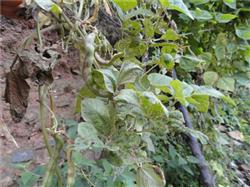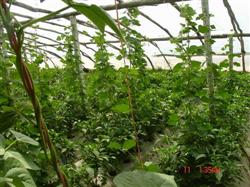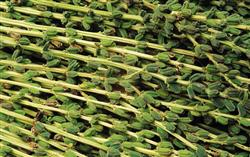Kidney bean planting: why kidney bean is deformed?

Why is kidney bean deformed? Please introduce the causes and control methods of kidney bean deformity mainly in pods, mostly showing a "curved hook". The causes of kidney bean deformity are caused by the following factors: first, spraying drugs that are sensitive to kidney beans. Kidney beans are sensitive to drugs containing mancozeb, mancozeb or acetamivir, such as excessive application, which can easily bend the pods. Kidney beans are very sensitive to poisonous alum and are prone to drug damage, resulting in pod deformities. There are also kidney beans due to spraying copper preparation or anthrax Fumei appeared drug damage, light pods bent, heavy leaves and pods. In the control of Botrytis cinerea, Sclerotinia sclerotiorum and other diseases, the safer drugs used on kidney beans are Prodnisolone, Sukeling, Chlorothalonil, Nongliling, Baikor, carbendazim and so on. When using copper preparation to control bacterial diseases, the dosage should be halved. Drugs containing mancozeb, mancozeb or aldicarb should be used carefully or not, so as to prevent drug damage, cause kidney bean deformity, affect yield and quality, and cause unnecessary losses. The second is boron deficiency. Kidney bean lack of boron is not easy to set pods, even if the pods sit, but the flower pods are long, the pods are curved, and the merchandise is poor. The solution is to spray 1200 times the boron in front of the Yun Dou flower. Third, too high or too low temperature will cause pods to bend. The most suitable temperature for kidney bean growth is 23: 25 ℃ in daytime, 18 ℃ at night, and 23 ℃ in flowering stage. Kidney bean pod setting will be affected if it is lower than 20 ℃ or higher than 30 ℃ in daytime. When flowering at noon, you must observe the temperature in the shed and regulate the temperature in the shed. In addition, in order to ensure that carbon dioxide enters the greenhouse early during the closed greenhouse in winter, photosynthesis is carried out early, after one hour of sunrise in winter, the vents are opened as soon as the temperature conditions permit, so as to increase the concentration of carbon dioxide in the greenhouse and maintain the normal photosynthesis. Fourth, the adverse environmental impact. Too dry soil or too much water in the greenhouse can easily cause what vegetable farmers call "hooks" in the pods that have just sat. This is because if the soil is too dry or too wet, the root system will be injured, resulting in plant weakness and affecting flowering and pod setting. To ensure that the pod does not bend, the root system must first grow healthily. Don't water before the flowers. Watering should be determined according to soil moisture, and fertilizing should be combined with watering after sitting pods. Before transplanting to flowering, water should be watered four times and small water should be watered. Generally, about 20 square meters of land should be watered per mu, instead of flooding to avoid root injury. Fifth, overuse of growth inhibitors. Vegetable farmers sprayed excessive inhibitors on kidney beans, such as dwarf, difenoconazole and other pesticides, which are easy to cause kidney beans to bend. When some vegetable farmers spray naphthalene acetic acid to prevent pods from falling, the pods are bent due to excessive concentration, which should also attract our attention. Sixth, the concentration of soil solution is too high, too much chemical fertilizer or saline-alkali soil will also cause pod deformities. In view of this, we should apply less chemical fertilizer and more humic acid fertilizer. When the pods grow to 3-4 cm long, 30-60 jin of humic acid fertilizers can be applied per mu to supplement nutrition. Excessive application of chemical fertilizer should not increase the concentration of soil solution and cause pods to bend. Soilless cultivation is the best way to grow kidney bean in saline-alkali soil, so as to avoid direct contact between kidney bean root system and saline-alkali soil and affect root growth. Click to get more kidney bean planting technology click to get more grain and oil crop planting technology
- Prev

Kidney bean planting: what if kidney beans do not bear pods?
What if kidney beans don't bear pods? What causes kidney beans not to blossom and not to bear pods? Please give an introduction and control methods kidney bean flower less, fine flowers and difficult to sit flowers is due to poor flower differentiation. The main reasons are as follows: 1. The temperature in the shed is too low, which directly affects the normal differentiation of flower buds or the development of flower organs.
- Next

Sesame planting: how to fertilize summer sesame?
How to fertilize summer sesame seeds? Please introduce fertilization methods for planting summer sesame in order to achieve high yield, it is necessary to re-apply basic fertilizer, shallow basic fertilizer, appropriate amount of seed fertilizer, re-application of flower bud fertilizer, and supplementary spraying of phosphorus and potassium fertilizer; mainly organic fertilizer, combined with phosphorus and potash fertilizer, reduce the amount of chemical fertilizer as far as possible to improve.
Related
- The first cup of black tea in spring, the flavor and history of tea gardens in Kenya, Africa
- The computer can not only choose potatoes, but also grow tea rice. AI will grow winter oolong tea champion.
- It is not only the inflated tea bitten by insects, but also engraved with the four seasons tea in Beipu.
- The Oriental Beauty Tea Festival in Zhuxian County takes the stage at the weekend to experience the plus-size feast of oil tea.
- & quot; Oriental Beauty Tea & Exploration of Emei in Hsinchu, the hometown of quot;
- The new variety of strawberry "Tainong 1" dessert is the first choice with mellow aroma. Crimson gorgeous
- History of Tea in Taiwan: from Wild Inner Mountain to Export Tea Garden
- Two types of Taiwan Oriental Beauty Black Tea won the British three-Star Award for Childhood Tea Xiang Zhang Jiaqi changed from pilot to champion tea maker.
- Banana species and varieties: the planting history of Taiwan Xianren banana and dwarf banana is long, is banana disease resistant?
- Coffee planting Technology: Qianjie Coffee from Seedling to harvesting

